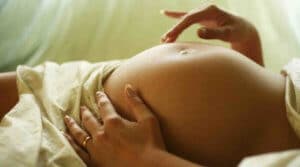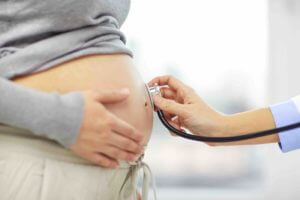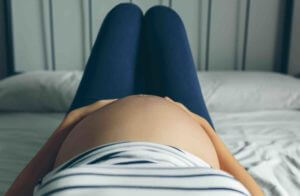A true fall birth rarely occurs. It is a true fall birth when the baby falls out of the vagina during delivery and cannot be held.
A fall birth carries the risk of injury to both mother and baby. It depends on quick action. A rushed birth requires quick help and proper action.
After a fall birth or a rushed birth, the baby can grow up normally and develop healthily. Contractions, when to go to the hospital?.
You should, if you have already had a rapid birth, go to the hospital quickly if you are in labor to prevent a fall birth with your second child.
In a true precipitous birth, the baby cannot wait and falls out of the vagina. A rushed birth occurs within a few hours.
Table of contents
What Is A Precipitous Birth?
A true precipitous birth is extremely rare and is when the baby falls out of the uterus and out of the vagina within a few minutes. The mother is usually standing when this happens, leading to a high risk of injury to both mother and baby.
To prevent a fall birth, you should go to the hospital if there are signs of labor. In the case of a precipitous birth, the birth can be induced with a strong expulsive contraction.
Often, a single expulsion contraction is enough to bring the baby into the world. Plunge birth is more likely to occur in women who have already given birth to one or more children.
A true fall birth occurs in only about 2 percent of women who deliver naturally. Lucky hood, in which the baby is born with its water broken, can be even rarer. However, this lucky hood rarely occurs in a fall birth.
Difference Between A Fall Birth And A Rushed Birth
A true precipitous birth should be distinguished from a rushed birth. Mostly, however, a rushed birth is called a falling birth. A rushed birth is when the birth happens very quickly.
A few hours pass from the beginning of labor to the birth.
According to the definition, it takes no more than three hours from the opening of the cervix to the arrival of the baby. However, on average, a birth takes twelve hours.
For women who have already had several children, a birth takes an average of six to eight hours. A true precipitous birth is also a rushed birth. A rushed birth is a completely normal birth, but it happens extremely quickly.
If it is a rushed birth according to the definition, the following happens:
- There are almost no contractions at all.
- The contractions are so weak that they are barely noticed.
- The birth process is initiated immediately with violent pushing contractions.
- The birth may occur with just one expulsive contraction.
It is also possible that mild contractions occur at longer intervals and are hardly noticed. Contractions, when to go to the hospital? If you are unsure, you should go to the hospital immediately when you feel contractions.
A rushed birth can take place in the hospital if you go there in time. However, just like a precipitous birth, it often happens at home, on the road, or on the way to the hospital. It usually happens without medical assistance.
Causes And Risks Of A Fall Birth
A falling birth can have several causes, which can come from the mother and the baby. The falling birth, or rushed birth, is more likely in women who have already given birth to several children than in women who are having their first child.
In these women, the birth canal is softer and stretches faster than in first-time mothers. It offers little resistance, so the cervix opens quickly.
If the birth canal is very soft, in extremely rare cases, the baby may be born with a happy hood. Labor, when to go to the hospital? Women who have already given birth to several children actually know this.
But even for them, the contractions can be weak, so they are hardly noticed.
What do labor pains feel like? Women who are having their first child don’t know this yet, so they already go to the hospital at the first signs of labor. This can help prevent a fall birth.
Other causes of a precipitous birth.
- Short consecutive pregnancies after which the birth canal has not fully receded.
- Increased labor activity with contractions about every three minutes.
- Low pain sensation of the mother, so that the contractions are not perceived as painful and are barely noticed.
- Severe soft tissue or uterine weakness in the mother.
- Infertility treatments.
- Placental abruption (in this case, the baby can be born with a lucky cap).
- Low birth weight, small size and narrow head circumference of the baby.
- First-time mothers who want to suppress or hide their pregnancy.
As varied as the causes and risks of a fall birth are, fall birth is rare. Often, there are multiple causes. Therefore, a fall birth cannot be prevented or stopped.
Contractions, when to go to the hospital? If you are not sure, then immediately to prevent a fall birth.
Possible Complications Of A Fall Birth
In a true fall birth, there may be complications for both mother and baby. The mother often does not make it back to lie down to give birth.
If a fall birth occurs, there may be severe pain due to labor, as well as tearing of the perineum and vagina. Injuries to the pelvic floor and postpartum bleeding are also possible.
If a woman represses pregnancy, she often cannot answer the question “Contractions, when to the hospital?” because she may mistake contractions for urges to have a bowel movement. Because of the feeling of pressure, she seeks the toilet.
The result is a falling birth as a toilet birth. Complications for the baby may result from a fall if the baby falls into the toilet or onto the floor. Not only head injuries, but also injuries to the torso, arms, and legs are possible.
Because the umbilical cord can break, high blood loss can occur. The umbilical cord can also wrap around the baby’s head or neck and, in the worst case, strangle the baby.
Blood oxygen saturation can also be compromised. A lack of oxygen and brain hemorrhage in the baby can also occur due to a lack of pressure adjustment in the birth canal during the expulsion phase.
If brain hemorrhage occurs, the baby must be monitored with intensive care. Because the baby is born very quickly, postnatal adaptation may be delayed.
Postnatal adaptation is the adjustment of the baby’s organism to the new environment outside the womb. The fall birth can cause psychological stress for the mother.
She did not expect that her baby would already be born. Even though in extremely rare cases the baby is born with a happy hood, it is an extremely unusual sight that can lead to shock reactions.
After repressed pregnancy, the mother often finds it difficult to accept the child after a fall birth. She was not prepared for it and therefore in some cases needs the help of a psychologist.
Threatened Fall Birth – What To Do?
If there is a threat of a fall birth or a rushed birth, the emergency doctor must be called. In this case, it is important not to lose any time.
If you notice contractions and cannot make it to the hospital because they are too strong and occur in quick succession, you should lie down in bed or on a pillow. Contractions – when to go to the hospital, that’s done.
If this is not possible, lie flat on the floor. In this way, you can prevent the child from falling. If you have already had children and the previous births were very fast, there is an increased risk of a falling birth.
Contractions, when to go to the hospital? In this case, you should go to the hospital at the first signs of labor to avoid a fall birth.
To reduce the risk of a falling birth, it is already a good idea to spend the last two weeks before your due date in the hospital. What do labor pains feel like? If you have already had children, you know this for the most part.
With breathing techniques taught in childbirth preparation courses, some women manage to delay the birth by at least a few minutes. Contractions, when to go to the hospital? You should breathe away the contractions.
You should stay calm and avoid extreme pushing to delay the birth as much as possible. However, a falling birth can only be delayed to a limited extent. If a person from your environment, ideally your partner, is near you, this person can help you during birth.
If you are on the road, you can approach a person near you. They can call the emergency doctor and assist you in the birth.
If The Situation Is Favorable And There Is Enough Time Left
If you are at home and notice signs of a birth, you can still take some measures to keep the risks for your child and for you as low as possible.
You should cover the birth area with large garbage bags and, if possible, with towels for padding. You should wash your hands thoroughly with soap and water. To give birth, you can lie on your back in the birthing area.
You can also kneel or squat down to soften the fall.
How To Give Birth
If you can still control the birth, you should breathe away the contractions. You should only push actively when you can feel the baby’s head between your labia.
If it is possible, you or your partner should place one hand on the back of the baby’s head to regulate the speed of the push. On the other hand, you should gently gather the perineum to avoid injury.
After the baby’s head has emerged from the vagina, push it out with the next contraction. Under no circumstances should you pull on the baby’s head, as this can lead to serious injuries.
Once the baby is born, you should not cut the umbilical cord yourself. You should wait until the doctor or midwife comes.
Baby Is Here And No Ambulance – What To Do?
If you have had a fall and the baby is already born, it is important to do the right thing if there is no ambulance, emergency doctor or midwife at the scene.
You should remove the mucus from the baby’s face. Even if it is not expelled with the entire amniotic sac as a lucky cap, it may still have egg membranes on its head or face.
These egg membranes are also called a lucky cap. The lucky cap must be removed quickly. If the lucky cap is complete, the amniotic sac must be carefully opened mechanically.
You should put the baby on your chest. If it does not breathe, you should gently rub its back. This will stimulate breathing. Cover the baby with a blanket to prevent it from getting cold. You can try to breastfeed the baby.
If the placenta is expelled, just leave it there.
Plunge Birth: Conclusion
A fall birth can happen in a matter of minutes. It is often confused with a rushed birth, which occurs within three hours. In labor, when to go to the hospital?
As soon as possible to prevent a precipitous birth. A precipitous birth can cause injury to the baby and high blood loss to the mother.
You should call 911 at the first sign and should remain calm.
Source
https://www.netdoktor.de/schwangerschaft/sturzgeburt/
https://www.eltern.de/schwangerschaft/geburt/sturzgeburt.html












